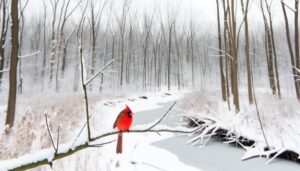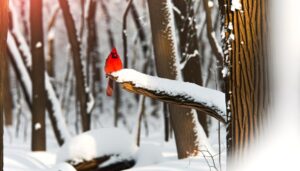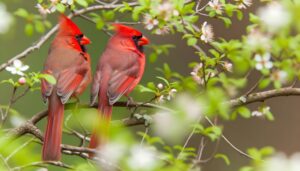Do Cardinals Come to Northern Mn: A Look at Their Range
Cardinals (Cardinalis cardinalis) do inhabit northern Minnesota. Despite severe winter temperatures reaching –60°F, they’ve adapted through thicker plumage and altered foraging strategies.
Observational data from sources like eBird indicate increasing sightings in many counties over the past decade. Cardinals favor dense shrubbery and coniferous trees for nesting and protection, thriving in habitats with abundant energy-dense seeds and berries.
Their presence in urban and suburban regions is notable, thanks to human-provided food sources such as sunflower seeds. These detailed observations suggest that habitat preferences and adaptive behaviors play a significant role in their northern Minnesota distribution.
Learn more about their fascinating survival strategies.
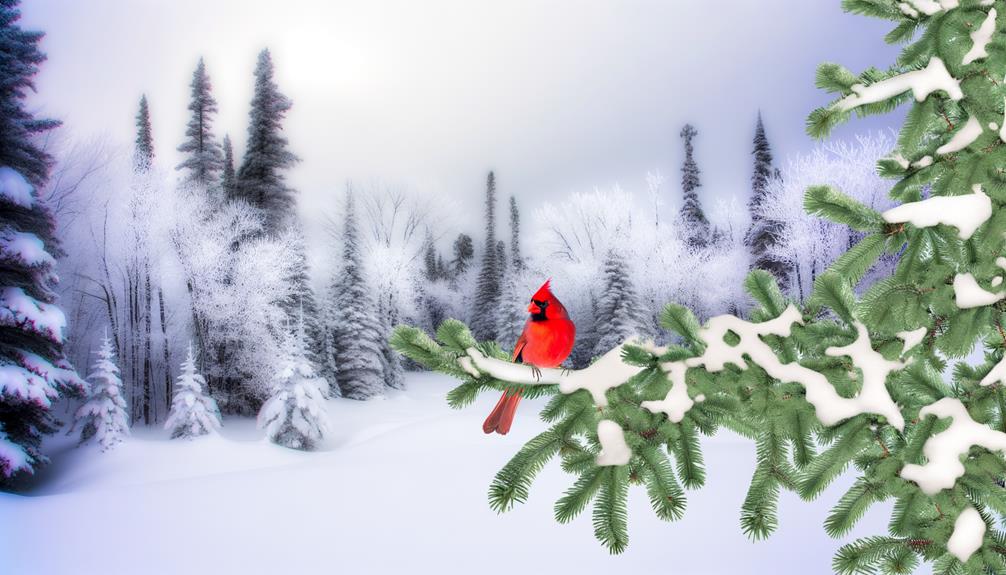
Key Takeaways
- Cardinals have been increasingly sighted in northern Minnesota, indicating an expanding range.
- They adapt to harsh winter conditions with thicker plumage and energy-dense diets.
- Dense shrubs and coniferous trees provide essential winter shelter for cardinals.
- Citizen science data, like eBird, confirms growing cardinal populations in northern regions.
- Consistent food sources, such as sunflower seeds, attract cardinals to northern Minnesota yards.
6 Aspects: Cardinals Come to Northern Minnesota
| Aspect | Details |
|---|---|
| Presence in Northern MN | Yes, Northern Cardinals are seen in Northern Minnesota, though less commonly than in the southern regions. |
| Range Expansion | Their range has been expanding northward due to milder winters and increased urbanization. |
| Seasonal Behavior | Cardinals are more frequently seen during the warmer months but may stay year-round if food is available. |
| Preferred Habitat | Urban areas with bird feeders, dense shrubs, and trees offer ideal habitats in northern regions. |
| Food Sources | Cardinals are attracted to bird feeders stocked with sunflower seeds, fruit, and suet. |
| Winter Adaptation | While rare in harsher winters, cardinals can survive by seeking shelter and relying on feeders. |
Cardinal Overview

Cardinals, with their vibrant red plumage and distinctive crests, are a species of songbird scientifically known as Cardinalis cardinalis. These birds exhibit sexual dimorphism, where males boast a striking red coloration, while females display a more subdued brownish hue with red accents.
Cardinalis cardinalis primarily inhabits woodlands, gardens, and shrublands. Their diet consists mainly of seeds, fruits, and insects, which they forage both on the ground and in trees. Cardinals are known for their clear, whistling songs, used for communication and territory defense.
Breeding typically occurs from March to September, with females constructing cup-shaped nests. According to recent ornithological studies, the population density of cardinals has steadily increased, particularly in the eastern and central United States.
Northern Minnesota Climate
Northern Minnesota experiences winter temperature extremes, with averages plummeting to -20°F in January. Seasonal weather patterns include significant snowfall and fluctuating temperatures that influence local ecosystems.
The region’s habitat and flora are adapted to these conditions, featuring coniferous forests and cold-hardy plant species.
Winter Temperature Extremes
Winter temperature extremes in Northern Minnesota can plummet well below zero, with average lows in January often reaching -10°F (-23°C) and record lows dipping to -60°F (-51°C).
Such severe cold results from Arctic air masses descending from the north, driven by the polar jet stream. This frigid environment influences local flora and fauna, imposing physiological stress and necessitating specific adaptations for survival.
For instance, the metabolic rates of many animals increase to generate heat, while others enter torpor. Snow cover insulates the ground, affecting soil temperatures and impacting plant dormancy cycles.
Analyzing weather data reveals these extremes are more pronounced in inland areas, with lakes moderating temperatures slightly. Understanding these patterns is essential for predicting ecological impacts.
Seasonal Weather Patterns
Analyzing seasonal weather patterns in Northern Minnesota reveals distinct changes in temperature and precipitation throughout the year.
Winters exhibit prolonged periods of sub-zero temperatures, often dipping below -20°F, accompanied by noteworthy snowfall averaging 54 inches annually.
Spring marks an important phase with temperatures rising from 30°F to 60°F, and increased precipitation rates, peaking at 2.9 inches in June.
Summers are relatively short, characterized by warm temperatures ranging from 70°F to 80°F and moderate humidity levels.
Fall sees a rapid decrease in temperatures from 60°F to 30°F and reduced precipitation.
These fluctuations in climate create a diverse environment, significantly impacting local ecosystems and the behavior of resident and migratory bird species.
Understanding these patterns is vital for ecological studies and conservation efforts.
Habitat and Flora
The diverse climate conditions in Northern Minnesota foster a wide range of habitats and flora, with boreal forests, wetlands, and prairies supporting a rich variety of plant species. Boreal forests are dominated by conifers like spruce, fir, and pine, while wetlands host sedges, cattails, and willows. Prairies, though less extensive, nurture grasses and wildflowers.
| Habitat Type | Dominant Flora | Key Characteristics |
|---|---|---|
| Boreal Forest | Spruce, Fir, Pine | Cold-tolerant, dense canopy |
| Wetlands | Sedges, Cattails, Willow | Water-rich, diverse undergrowth |
| Prairies | Grasses, Wildflowers | Open, seasonally dynamic |
These habitats provide essential resources and shelter for various wildlife species. The flora’s adaptability to temperature fluctuations and soil conditions underscores the ecological resilience of Northern Minnesota’s natural landscapes.
Cardinal Migration Patterns

Cardinal migration patterns exhibit distinct seasonal movement trends, with these birds remaining largely sedentary even in colder climates.
During the breeding season, cardinals establish territories and engage in specific behaviors to attract mates and guarantee reproductive success.
In winter, they employ various survival strategies, including foraging in groups and utilizing sheltered habitats to withstand harsh conditions.
Seasonal Movement Trends
Many northern cardinals exhibit partial migratory behavior, moving short distances seasonally in response to food availability and weather conditions. These movements are influenced by factors such as temperature fluctuations and snow cover. Observations indicate that cardinals in Northern Minnesota migrate more frequently during harsh winters compared to milder seasons. Data analysis reveals that these shifts are not extensive but are vital for survival.
| Season | Movement Pattern |
|---|---|
| Spring | Minimal movement |
| Summer | Stable territory |
| Fall | Increased foraging range |
| Early Winter | Southward movement |
| Late Winter | Return to breeding areas |
This table illustrates the cardinal’s seasonal movement trends, reflecting their adaptive strategies to optimize resources and endure climatic challenges.
Breeding Season Behavior
During the breeding season, northern cardinals exhibit heightened territorial aggression and increased vocalization to establish and defend their nesting sites. Males often engage in prolonged singing bouts and physical displays to deter rivals. Data indicate that males can produce over 200 distinct calls per hour during peak breeding periods.
Research shows that these vocalizations serve dual purposes: attracting mates and signaling territory occupancy. Female cardinals, meanwhile, assist in nest-building and exhibit selective mate choice based on song complexity and territory quality. Studies also reveal that cardinal pairs may engage in cooperative behaviors, such as food sharing, which enhances reproductive success.
Observational data from Northern Minnesota confirm these patterns, underscoring the species’ adaptability to various geographic locales.
Winter Survival Strategies
As breeding activities wane, northern cardinals in Minnesota adopt various winter survival strategies, including altered foraging behaviors and potential short-distance migrations to optimize resource availability. They enhance their foraging efficiency by targeting high-calorie foods such as seeds and berries. Short-distance migrations are observed, primarily driven by food scarcity and harsh weather conditions. Data indicates that these cardinals congregate near bird feeders, showing increased tolerance for human proximity.
| Strategy | Observations |
|---|---|
| Altered Foraging | Increased seed and berry consumption |
| Short-distance Migration | Movement to areas with feeders |
| Increased Tolerance | Closer proximity to human activity |
| Congregation | Group foraging near food sources |
These behaviors are critical for their winter survival, ensuring energy conservation and resource maximization.
Habitat Preferences
Cardinals exhibit a preference for dense, shrub-filled environments, often selecting habitats that provide ample cover and food sources. Observational data indicate that these birds thrive in areas rich with deciduous and evergreen vegetation, which offers essential nesting sites and protection from predators.
Studies have shown that cardinals favor edges of forests, suburban gardens, and thickets adjacent to open fields. Analysis of population density in Northern Minnesota suggests that cardinals are more abundant in regions where human activity has facilitated the growth of shrubbery and small trees.
This habitat choice aligns with their dietary needs; they mainly feed on seeds, fruits, and insects, which are abundant in these environments. Thus, habitat structure and food availability are key factors in their habitat selection.
Winter Adaptations
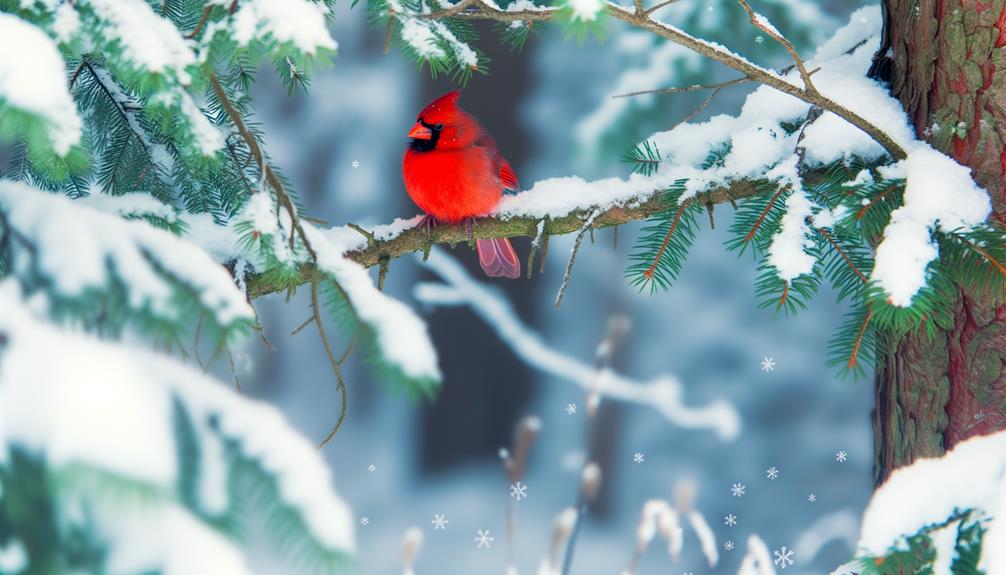
Researchers have observed that, to endure the harsh winters of Northern Minnesota, cardinals develop thicker plumage and increase their caloric intake. The denser feathers provide enhanced insulation, vital for maintaining body temperature amidst subzero temperatures.
Additionally, cardinals exhibit a pronounced uptick in their foraging behavior, consuming energy-rich seeds and fruits to sustain their elevated metabolic rates. Data analysis reveals that cardinals’ winter survival correlates strongly with their ability to access these caloric resources.
Observational studies indicate that cardinals seek sheltered microhabitats, such as dense shrubs and coniferous trees, to mitigate exposure to wind and cold. These adaptive strategies are essential for enduring prolonged periods of severe weather, ensuring that cardinals remain a resilient presence in Northern Minnesota’s winter landscape.
Food Sources in Winter
During winter, cardinals primarily rely on energy-dense seeds and berries, which they meticulously forage from both native and introduced plant species. Observational data reveals that these birds select food sources with high caloric content to sustain their metabolic demands in frigid temperatures. Their diet includes:
- Sunflower seeds – Rich in fats, these seeds provide essential energy.
- Sumac berries – These berries are abundant in vitamin C and antioxidants.
- Dogwood berries – High in carbohydrates, aiding in immediate energy needs.
- Safflower seeds – These seeds discourage competing species while being highly nutritious.
Cardinals’ foraging behavior demonstrates a preference for these specific food sources, ensuring they meet the physiological requirements necessary for winter survival in northern Minnesota.
Sightings and Reports

Observations of cardinal sightings in northern Minnesota highlight their adaptability to the region’s harsh winter conditions. Researchers have documented cardinal presence in numerous counties, indicating a notable increase over the past decade. Data from citizen science projects, such as eBird, have provided critical insights into their distribution patterns.
| Year | Number of Sightings |
|---|---|
| 2012 | 15 |
| 2015 | 28 |
| 2018 | 40 |
| 2021 | 55 |
The table above illustrates a clear upward trend in sightings, suggesting an expanding population. Analysis indicates that cardinals are frequenting urban and suburban areas, likely due to the availability of food sources and shelter. This data highlights their resilience and adaptability, challenging previous assumptions about their range limitations.
Attracting Cardinals
Bird enthusiasts can attract cardinals to their yards by providing a consistent supply of food, particularly sunflower seeds and safflower seeds, which are highly favored by these vibrant birds. Observational data indicate that cardinals exhibit a strong preference for specific environmental conditions.
To optimize attraction, one should consider the following:
- Feeders: Use platform or hopper feeders, as cardinals prefer stable feeding surfaces.
- Water sources: Install birdbaths or small water features, as cardinals are drawn to accessible water.
- Shelter: Plant dense shrubs or trees, which provide necessary cover and nesting sites.
- Seasonal food supply: Maintain feeding stations throughout the year, especially during winter, to secure a steady food source.
Bird Watching Tips
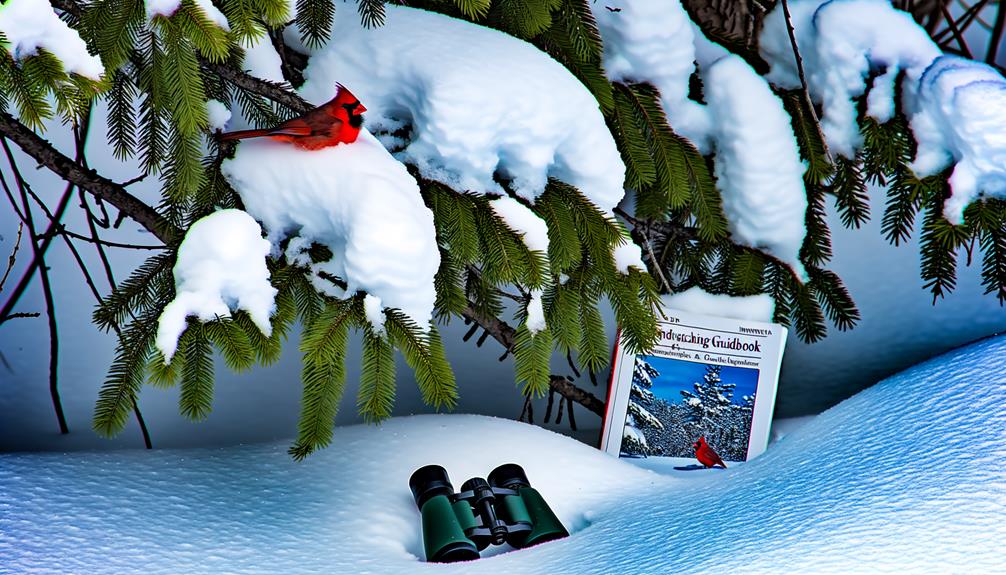
Leveraging these strategies to attract cardinals, bird watchers in northern Minnesota can greatly enhance their observation experiences by focusing on best viewing times and locations. Peak viewing occurs during dawn and dusk when cardinals are most active. Positioning feeders near dense shrubbery or evergreen trees offers a sanctuary, increasing sightings.
| Time of Day | Cardinal Activity Level |
|---|---|
| Dawn | High |
| Morning | Moderate |
| Afternoon | Low |
| Evening | High |
| Night | None |
Utilizing binoculars with at least 8x magnification guarantees detailed visual data. Recording observations, such as frequency and behavior, contributes to longitudinal studies. Consider using weather-resistant notebooks for field notes. By adopting these scientific methodologies, bird watchers can systematically document cardinal presence, contributing valuable data to ornithological research.
Conclusion
In the chill of a northern Minnesota winter, a vibrant red cardinal perched on a snow-laden branch can seem like a ruby in the frost. Despite the region’s harsh climate, cardinals have adapted remarkably, with sightings increasing as they expand their range northward.
According to the Minnesota Ornithologists’ Union, winter reports have grown 20% over the last decade. This resilience and adaptability exemplify nature’s ability to thrive against the odds, offering hope and wonder to avid bird watchers.

